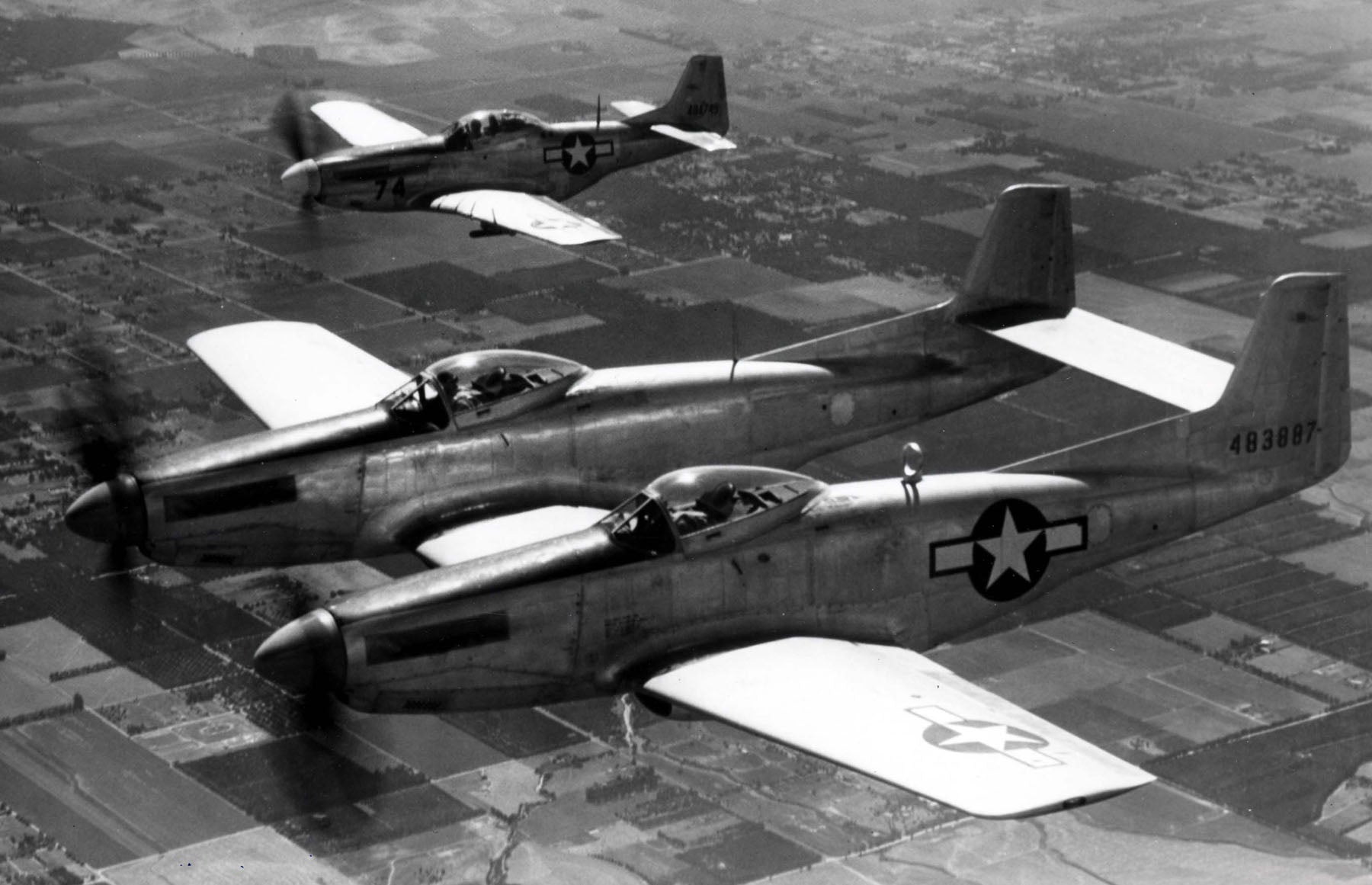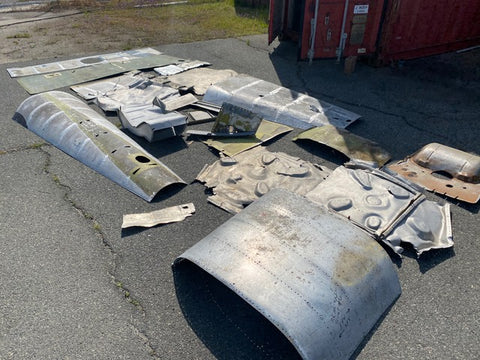
- by Dianna Lopez
XP-82 Twin Mustang: A One of a Kind, Piston Powered Fighter
- by Dianna Lopez
A question? Visit our contact page
This site uses cookies for better user experience and analytics.

The Twin Mustang was built with an audacious design and a specific purpose - to escort a fleet of bombers further than any other aircraft USAF was capable of at the time. While they weren’t operational in time to accomplish that specific task during WWII these versatile planes went on to fulfill many other missions. Read about 44-83887, an ultra-rare prototype XP-82 that remains the only airworthy Twin Mustang left today. MotoArt had the opportunity to acquire the original aircraft skin that was removed in restoring 887 to flying condition and turn it into something new. Let’s take a closer look at the Twin Mustang and a one of a kind XP-82.

By United States Air Force - Dean, Jack. "The Lonely Long Ranger." Airpower Magazine, September 1987 Image source listed as United States Air Force, Public Domain, Link
The North American Aviation F-82 Twin Mustang was a long-range, high altitude escort fighter, produced for the USAF. It was the last piston-engined fighter ordered into production and was based on the P-51 Mustang. It was initially intended to escort Boeing B-29 Superfortresses on longer missions during World War II but the war ended before they were operational. It was versatile and could adapt to many roles, including long-range escort, fighter, attack bomber, rocket fighter, interceptor, and long-range reconnaissance. They were used during the Korean War. Only 272 were manufactured.

It was formed by two fuselages which were joined at the horizontal stabilizer and wing. Each fuselage had its own pilot, each of whom could control the engine throttles and propellers. The left pilot contained the normal flight and engine instruments; the co-pilot in the right could operate their controls during an emergency or to relieve the pilot.

The XP-82 variant was a prototype, equipped with Packard Merlin V-1650-23 and -25 engines. Only two were built, not including the XP-82A, of which one was built and the second canceled, or other variants. Today, there are only a handful of Twin Mustangs of any variant remaining, one of which is 44-83887.

More F-82 facts at nuclearcompanion.com.

By U.S. Air Force - http://www.nationalmuseum.af.mil/factsheets/factsheet.asp?id=2293 (direct link), Public Domain, Link
887 was produced circa 1944 and was the second of two XP-82 prototypes. Although they accepted by the USAF in 1944, it like the other 82s never saw combat during World War II. Instead, took its first flight on April 15, 1945 and immediately went to NACA, the predecessor to NASA.

The National Advisory Committee for Aeronautics (NACA) was established in 1915, during World War I, to manage and conduct the United States’ aeronautical research. One of its four centers was the Aircraft Engine Research Laboratory, Lewis Research Center in Cleveland, Ohio. It was here that 887 was stationed and served as a ramjet testbed, specifically for an eight machine gun center pod, underwing rockets, and a radar pod.
During WWII, NACA assisted in resolving operating problems with piston-engine aircraft, among other studies. After the war, NACA continued to research and test many developments that benefited the military and civilian aeronautics. In 1958, it was evolved to include space, and its centers became the nucleus of the National Aeronautics and Space Administration (NASA).
On December 15, 1949, 887 was damaged beyond repair after it skidded off an icy runway. It was struck off strength/charge from the Air Force. It was later acquired by Walter Soplata for his collection around 1965, for $300. It remained at the Soplata property until purchased by Tom Reilly.

Famed master restorer Tom Reilly has been restoring planes for 50 years, including 44-83887. He met Walter and Margaret Soplata sometime during the 1990’s when he was doing appraisal work for them. Walter had a F-82 that Reilly was interested in restoring but by the time he was able to purchase it in 1997, it had already been sold. Ten years later, in December 2007, Reilly was again at the Soplata location, performing another appraisal, when he spotted a Mustang fuselage hidden behind some sheet metal. Actually, Soplata informed him, it was not a Mustang but the prototype P-82. Although the Soplatas were not ready to sell it, they promised Reilly he would have the first option to buy it if they ever were.
Reilly began looking for P-82 parts and salvages, in the hopes that he would be able to buy the fuselage and parts from the Soplatas. He also began assembling potential investors to help fund the expensive restoration project. The good news is that in April 2008, Margaret Soplata invited Reilly to Ohio to discuss the P-82.
Watch Tom Reilly describe it in his own words.
The story of the restoration of 887 is one of dogged determination and a labor of love. Reilly had amassed parts from Alaska, Colorado and other sources, as well as had the assistance of craftsmen and women to repair, rebuild, or recreate what was needed to return the plane to flyable condition. The project took ten and a half years and 207,000 man and woman hours.

“We were really excited to get this material from the restoration,” says MotoArt owner Dave Hall. “Only 272 Twin Mustangs were produced and most of them were scrapped. We are just so honored to make an XP-82 PlaneTag to keep the memory of the Twin Mustang alive. It’s cool to imagine those who flew in them being able to share memories and this collectible with their children and grandchildren.”

The XP-82 Twin Mustang PlaneTags are numbered to 1,700. They are made from the original parts from the restoration of #44-83887. Each PlaneTag is hand stamped, then smoothed and polished and attached to the collector's display card. We take great pride in the quality of PlaneTags because we know how much they mean to ourselves and our customers.
Add one to your collection or engrave one and give it as a gift. They are more than luggage tags and these will be a standout favorite in your collection.
P-51K Mustang: One Plane's Journey
The Soplata Collection: Preserving Planes for over 70 years
From Warbird to Water Bomber: The Epic Life of the Hawaii Mars
In the world of aviation, few aircraft have lived a life as large, or as long, as the Hawaii Mars. Towering over most of its contemporaries with a wingspan of 200 feet, this mighty flying boat was born in the final days of World War II, then quietly transformed into one of the most iconic aerial firefighting aircraft the world has ever seen. From military transport to firefighting titan, the Hawaii Mars represents one of aviation’s most extraordinary second acts.
In 2025, MotoArt obtained an original wing of this aircraft and created special PlaneTags, made exclusively for the Martin family members and Mars workers. On December 11, 2025, Hawaii Mars PlaneTags will be available to the general public for the first time.
F-14 Tomcat Coasters: A Legendary Fighter Reimagined for Your Home
Few aircraft define an era quite like the Grumman F-14 Tomcat. Sleek, powerful, and unmistakably iconic, the Tomcat was the Navy’s premier fleet defense fighter for more than three decades. From Cold War missions to pop culture stardom, the F-14 remains one of the most recognizable and beloved aircraft ever built. Today, MotoArt is proud to introduce the F-14 Tomcat Coaster Set, created from authentic F-14 aircraft material.
PR-AJB: The Story of an Azul Airbus A320 With a Global Journey
Every airplane has a story, and some travel farther than others before their flying days are over. PR-AJB was one of those well-traveled aircraft. This Airbus A320 started its life flying British families on long-awaited holidays, then later crossed the Atlantic to join the growing fleet of Azul Linhas Aéreas Brasileiras. Over nearly nineteen years it picked up new registrations, new paint, new routes and a new home, carrying thousands of passengers along the way.
Its journey reflects how widely the A320 family has spread around the world and how easily these aircraft adapt to whatever their next chapter requires. PR-AJB also arrived at Azul during an important period of expansion as the airline worked to connect more cities across Brazil. In this blog we will explore where the aircraft came from, what it did during its short time with Azul, and how it eventually came to rest in Florida. We will also share how MotoArt recovered material from the retired airframe and created PlaneTags so its story can continue in a new way.


Share:
TWA DC-9: Bringing The Globe To The Heartland
United Airlines Boeing 727: Flying The Friendly Skies